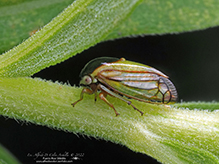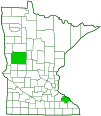treehopper
(Acutalis tartarea)
Conservation • Description • Habitat • Ecology • Distribution • Taxonomy
Conservation Status |
|
|||||||
| IUCN Red List | not listed |
|||||||
| NatureServe | NNR - Unranked |
|||||||
| Minnesota | not listed |
|||||||
Description |
||
Acutalis tartarea is a common, small, typical treehopper. It occurs in the United States and southern Canada east of the Great Plains. It is common in the east, but uncommon in Minnesota, where it reaches the western extent of its range. Adults are active from June to October in Minnesota. They are found in a variety of habitats, including mixed forests, hardwood forests, and forest edges. Though called treehoppers, they are most common on herbaceous plants, especially plants in the Aster (Asteraceae) family. They feed on juices from the leaves and stems of plants. Adults are ⅛″ to 3⁄16″ (2.8 to 4.5 mm) in length. The head is two times as wide as long. The mouthparts are optimized for piercing and sucking. The plate on the thorax (pronotum) is large. It extends backward to the tip or almost to the tip of the abdomen, but it does not extend to the tip of the wings. There are two pairs of wings, and they are held roof-like over the body when at rest. The forewings (hemelytra) are thickened, are longer than the body, and completely cover the sides of the body. Three veins extend backward from near the base of each hemelytron. There is a cross vein between the media (M) and cubitus (cu) veins, but there is no sectorial (s) cross vein between the two branches of the radial sector (Rs) vein. There are four or five cells near the tip. Acutalis tartarea is highly variable in both size and coloration, and this has led to several species being described in the past. Three of these species are now considered to be synonyms of one highly variable species. The variations fall into three consistent color morphs. The dark morph, previously A. tartarea, is the most common morph in the northeast, north-central, and west-central regions of North America. The head, pronotum, body, and the portion of the hemelytra that cover the body, are black. The light morph, previously A. inornata, is mostly in Florida, though some have been found further north. It is entirely green with no black markings. The intermediate morph was previously A. semicrema. Its range is similar to that of the dark morph. It is green with black on the head and on the ridge of the pronotum. |
||
Size |
||
Total length: ⅛″ to 3⁄16″ (2.8 to 4.5 mm) |
||
Similar Species |
||
Habitat |
||
A variety of habitats, including mixed forests, hardwood forests, and forest edges |
||
Ecology |
||
Season |
||
June to October |
||
Behavior |
||
Adults are active during the day |
||
Life Cycle |
||
Eggs are laid in multiple clusters of 12 to 15 each. They are shallowly inserted into the stem or the leaf axis of a host plant, leaving them partially exposed. |
||
Nymph Food |
||
|
||
Adult Food |
||
Plant juices |
||
Distribution |
||||
|
Sources |
|||
| 11/9/2023 | ||||
Occurrence |
||||
Common in the east and the south, uncommon in Minnesota |
||||
Taxonomy |
|||
Order |
Hemiptera (True bugs, Hoppers, Aphids, and Allies) | ||
Suborder |
Auchenorrhyncha (true hoppers) | ||
Infraorder |
Cicadomorpha (spittlebugs, cicadas, leafhoppers and treehoppers) | ||
Superfamily |
Membracoidea (leafhoppers and treehoppers) | ||
Family |
Membracidae (typical treehoppers) | ||
Subfamily |
Smiliinae | ||
Tribe |
Acutalini | ||
Genus |
Acutalis | ||
Synonyms |
|||
Acutalis anticonigra Acutalis brunnea Acutalis inornata Acutalis semicrema Acutalis tartarea inornata Acutalis tartarea semicrema Acutalis tartarea tartarea Micrutalis semicrea Micrutalis tartarea Tragopa brunnea |
|||
Common Names |
|||
This species has no common name. The common name of the Family Membracidae is typical treehoppers, and it is used here for convenience. Project Noah uses the common name “Black-Veined Treehopper,” and Jungle Dragon uses the common name “Black Leafhopper,” but those names could not be found anywhere else. |
|||
Glossary
Hemelytron
The forewing of true bugs (order Hemiptera), thickened at the base and membranous at the tip. Plural: hemelytra.
Pronotum
The exoskeletal plate on the upper side of the first segment of the thorax of an insect.
Visitor Photos |
|||||
Share your photo of this insect. |
|||||
| This button not working for you? Simply email us at info@MinnesotaSeasons.com. Attach one or more photos and, if you like, a caption. |
|||||
Alfredo Colon |
|||||
 |
|||||
MinnesotaSeasons.com Photos |
|||||
|
|||||

Slideshows |
||

Visitor Videos |
|||
Share your video of this insect. |
|||
| This button not working for you? Simply email us at info@MinnesotaSeasons.com. Attach a video, a YouTube link, or a cloud storage link. |
|||
Other Videos |
|||
| Acutalis tartarea treehopper staring at the fuzz Insects and Animals |
|||
About
Aug 16, 2021 |
|||

Created: 11/9/2023
Last Updated:


